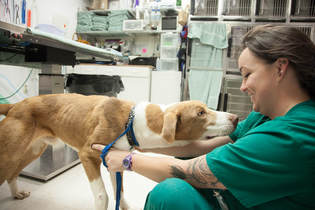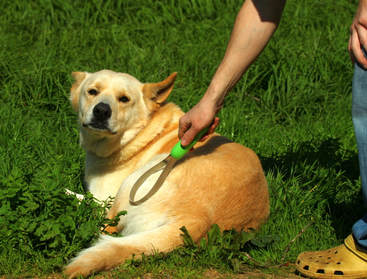Set Your Dog Up for a Healthy Lifestyle:
Five Tips for Preventing Illness in Dogs
Submitted by Melanie Pleasant
Outreach Manager for Dr. Dobias Natural Healing. https://peterdobias.com/
Five Tips for Preventing Illness in Dogs
Submitted by Melanie Pleasant
Outreach Manager for Dr. Dobias Natural Healing. https://peterdobias.com/

We all wish we could extend the lives of our beloved dogs so they could be with us forever. Unfortunately, they age faster than we do. But that doesn’t mean your furry best friend’s health and longevity is entirely out of your control.
There are many things you can do to promote your pup’s health. The good news is it is never too late to set your dog up for a healthy or healthier life.
Following are five tips that you can begin anytime, regardless of whether you are a dog expert or you just brought your first puppy home last week.
Courtesy of Flickr
1. Bring your dog for an annual wellness exam
Bring your dog for his annual wellness exam with your veterinarian. If you get your dog as a puppy, bring him to meet the vet when he comes into your family. The vet will want to get a baseline exam so that he or she can be aware of changes in the future.
The yearly exam is a time to check your dog’s weight, joints, heart, ears, as well as a time to give him any necessary vaccinations or booster shots.
This is also a good opportunity for you to talk with your veterinarian and discuss any questions or concerns that you might have about your dog’s health.
Senior health checks
Once your dog becomes a senior, it is a good idea to bring him for two exams yearly. This is because the health needs of senior dogs change. Your vet will want to monitor your dog to see if he needs a different diet, more or less exercise, and keep closer tabs on his overall health.
So, how do you know when your dog should be receiving his AARBark card? Senior status in dogs differs based on breed, health, and size. That being said, dogs are considered seniors in their mid to late 40’s, which is roughly around age seven (in human years).
2. Include exercise in your dog’s routine
Obesity is not just a human epidemic. More and more dogs are becoming overweight and suffering many of the same health issues as overweight people.
Overweight dogs are at a higher risk for diabetes, bone diseases, joint pain, heart disease, lung disease, and cancer, all of which can shorten life expectancy.
Even if you play with your dog and you take brief walks, your dog may not be getting enough aerobic exercise to prevent him from becoming overweight.
If you are tired of the same old walks, switch up the routine. Take your dog hiking. Or enlist him as a jogging partner. As always, we recommend consulting your veterinarian before starting a new exercise regimen.
Picture courtesy of Pixabay
There are many things you can do to promote your pup’s health. The good news is it is never too late to set your dog up for a healthy or healthier life.
Following are five tips that you can begin anytime, regardless of whether you are a dog expert or you just brought your first puppy home last week.
Courtesy of Flickr
1. Bring your dog for an annual wellness exam
Bring your dog for his annual wellness exam with your veterinarian. If you get your dog as a puppy, bring him to meet the vet when he comes into your family. The vet will want to get a baseline exam so that he or she can be aware of changes in the future.
The yearly exam is a time to check your dog’s weight, joints, heart, ears, as well as a time to give him any necessary vaccinations or booster shots.
This is also a good opportunity for you to talk with your veterinarian and discuss any questions or concerns that you might have about your dog’s health.
Senior health checks
Once your dog becomes a senior, it is a good idea to bring him for two exams yearly. This is because the health needs of senior dogs change. Your vet will want to monitor your dog to see if he needs a different diet, more or less exercise, and keep closer tabs on his overall health.
So, how do you know when your dog should be receiving his AARBark card? Senior status in dogs differs based on breed, health, and size. That being said, dogs are considered seniors in their mid to late 40’s, which is roughly around age seven (in human years).
2. Include exercise in your dog’s routine
Obesity is not just a human epidemic. More and more dogs are becoming overweight and suffering many of the same health issues as overweight people.
Overweight dogs are at a higher risk for diabetes, bone diseases, joint pain, heart disease, lung disease, and cancer, all of which can shorten life expectancy.
Even if you play with your dog and you take brief walks, your dog may not be getting enough aerobic exercise to prevent him from becoming overweight.
If you are tired of the same old walks, switch up the routine. Take your dog hiking. Or enlist him as a jogging partner. As always, we recommend consulting your veterinarian before starting a new exercise regimen.
Picture courtesy of Pixabay

3. Prevent illnesses that are preventable
Keeping your dog up-to-date on necessary vaccinations and including a daily exercise routine is already half the battle. So what other illnesses can you prevent in your pooch?
As for preventable illnesses that end up in veterinarians’ offices,
“Heartworm tops the list,” says Dr. Duffy Jones, owner of Peachtree Hills Animal Hospital in Atlanta.
Heartworm disease is caused by a parasite that is spread through mosquito bites, and it can be fatal if left untreated. However, there are several preventative treatments for the disease. If your dog does contract it, it is treatable if caught early enough.
Talk to your vet about a year-round heartworm prevention plan.
Picture courtesy of Wikimedia Commons
4. Feed beneficial probiotics
Perhaps you have already heard about the many benefits of probiotics. Probiotics, often referred to as “good bacteria,” are live microorganisms that live in different parts of the (dog and human) body, including the gastrointestinal tract.
These good bacteria are not only necessary for your dog’s digestive system, they also play an important role in boosting immunity.
“Probiotics can offer many of the same stomach-calming, immune-boosting benefits for animals and humans,” says Sherry Sanderson, an associate professor at the University of Georgia College of Veterinary Medicine.
A North Carolina State University College of Veterinary Medicine study found that one probiotic strain was as effective as an antibiotic in managing diarrhea in shelter dogs. Probiotics also don’t have the side effects that antibiotics do.
You want to make sure that you choose a probiotic that is specifically designed for the health needs of dogs, such as GutSense certified organic probiotic for dogs.
5. Brush your dog from nose to paws
It’s a good idea to get in a regular habit of brushing your dog, either every day (if you have a long-haired dog who tends to shed) or every other day. If you have a short-haired dog, you may opt for once or twice weekly.
The nose to paws brushing not only keeps your dog’s coat looking great, but gives you an opportunity to check your dog’s body for lumps, bumps, or sores that you might not otherwise notice.
You can also check for anything that might be stuck in your pup’s coat.
If you live in a wooded area, you should feel and look for ticks and flea dirt (eggs)..
If your dog does get fleas, or you notice excessive scratching, speak to your vet. You can use a natural flea treatment like FleaHex, a two-step, plant-based flea control for dogs to treat your dog, as well as areas inside your home.
An ounce of prevention
These five tips can go a long way toward preventing illness and setting your dog up for a healthy and happy life.
We have all heard the old saying, “an ounce of prevention is worth a pound of cure.” When it comes to certain truths, there is a reason old sayings get to be old sayings.
Sources:http://vrcmalvern.com/daily-dog-exercise-to-prevent-serious-diseases/
https://www.dog-care-knowledge.com
https://www.dog-care-knowledge.com/geriatric-dog-care
https://www.prevention.com/health/home-remedies-to-keep-your-dog-healthy
http://www.dogsnaturallymagazine.com
http://www.thedogdaily.com/health/illness
https://peterdobias.com/collections/all
Keeping your dog up-to-date on necessary vaccinations and including a daily exercise routine is already half the battle. So what other illnesses can you prevent in your pooch?
As for preventable illnesses that end up in veterinarians’ offices,
“Heartworm tops the list,” says Dr. Duffy Jones, owner of Peachtree Hills Animal Hospital in Atlanta.
Heartworm disease is caused by a parasite that is spread through mosquito bites, and it can be fatal if left untreated. However, there are several preventative treatments for the disease. If your dog does contract it, it is treatable if caught early enough.
Talk to your vet about a year-round heartworm prevention plan.
Picture courtesy of Wikimedia Commons
4. Feed beneficial probiotics
Perhaps you have already heard about the many benefits of probiotics. Probiotics, often referred to as “good bacteria,” are live microorganisms that live in different parts of the (dog and human) body, including the gastrointestinal tract.
These good bacteria are not only necessary for your dog’s digestive system, they also play an important role in boosting immunity.
“Probiotics can offer many of the same stomach-calming, immune-boosting benefits for animals and humans,” says Sherry Sanderson, an associate professor at the University of Georgia College of Veterinary Medicine.
A North Carolina State University College of Veterinary Medicine study found that one probiotic strain was as effective as an antibiotic in managing diarrhea in shelter dogs. Probiotics also don’t have the side effects that antibiotics do.
You want to make sure that you choose a probiotic that is specifically designed for the health needs of dogs, such as GutSense certified organic probiotic for dogs.
5. Brush your dog from nose to paws
It’s a good idea to get in a regular habit of brushing your dog, either every day (if you have a long-haired dog who tends to shed) or every other day. If you have a short-haired dog, you may opt for once or twice weekly.
The nose to paws brushing not only keeps your dog’s coat looking great, but gives you an opportunity to check your dog’s body for lumps, bumps, or sores that you might not otherwise notice.
You can also check for anything that might be stuck in your pup’s coat.
If you live in a wooded area, you should feel and look for ticks and flea dirt (eggs)..
If your dog does get fleas, or you notice excessive scratching, speak to your vet. You can use a natural flea treatment like FleaHex, a two-step, plant-based flea control for dogs to treat your dog, as well as areas inside your home.
An ounce of prevention
These five tips can go a long way toward preventing illness and setting your dog up for a healthy and happy life.
We have all heard the old saying, “an ounce of prevention is worth a pound of cure.” When it comes to certain truths, there is a reason old sayings get to be old sayings.
Sources:http://vrcmalvern.com/daily-dog-exercise-to-prevent-serious-diseases/
https://www.dog-care-knowledge.com
https://www.dog-care-knowledge.com/geriatric-dog-care
https://www.prevention.com/health/home-remedies-to-keep-your-dog-healthy
http://www.dogsnaturallymagazine.com
http://www.thedogdaily.com/health/illness
https://peterdobias.com/collections/all
